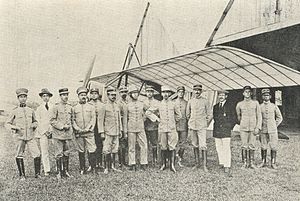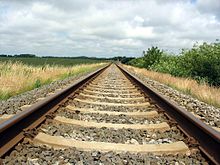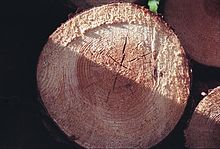Guerra do Contestado
| date | October 1912 to August 1916 |
|---|---|
| place | Santa Catarina & Paraná , South Brazil |
| output |
The Contestado Uprising , Portuguese Guerra do Contestado , (( f. Sg. ), Also: Contestado movements , English: Contestado War , Contestado Rebellion ) was a guerrilla war for land in Brazil between the Brazilian state police and rebels in October 1912 to August 1916.
The conflict was about a region in the south of Brazil that is rich in wood and mate bush plantations. It was called a "Contestado" because the states of Paraná and Santa Catarina , as well as Argentina, laid claim to the area. The occasion was social conflicts that led to local disobedience and were directed against the prevailing land distribution. The local Caboclos in particular were affected by injustices. But the conflict was also pervaded by religious fanaticism, which was reflected in messianic ideas and the belief of the Caboclos that they were involved in a religious war .
background
Social position of monks
The origins of the Guerra do Contestado can be understood when looking at the position of three monks . The first of them to gain fame was João Maria , a native Italian who roamed the area from 1844 to 1870, preaching and visiting the sick. He led a simple life and his ethics and lifestyle drew thousands of followers. Some sources say he died in 1870. In fact, however, he left Brazil in 1852. He migrated through Mexico , Cuba and Canada and was killed in Mesilla , New Mexico USA in April 1869 .
A second monk also took the name João Maria . His original name was Atanás Marcaf , possibly with Syrian roots. He appeared in public at the Revolução Federalista in 1893; he belonged to the Maragato faction and had clear and messianic views. He even published prophecies about the political events of his time and moved in the region between the Rio Iguaçu and the Rio Uruguay . Some of his followers even waited for his resurrection after his disappearance in 1908.
The wait ended in 1912 when a third monk went public. He was initially known as a herbalist and introduced himself under the name of José Maria de Santo Agostinho . The police of Vila de Palmas , Paraná, however, described him as a deserter convicted of rape under the name of Miguel Lucena de Boaventura .
Since his origin was unknown and he led an honorable life, it was easy for him to win the admiration of the people and their trust. Several miracles have been attributed to him: the resurrection of a young woman (who may have just experienced tetanus ) and the healing of Colonel Francisco de Almeida's wife . But it was all the more popular because he refused the land and money that the grateful Colonel offered him.
Since that event, José Maria has been considered a saint . Methodical and well organized, he differed significantly from other healers. he could read and write and noted in his notebooks the medicinal properties of the plants found in the area. With the permission of Colonel Almeida, he set up the "farmácia do povo" (pharmacy for the poor) on the ranch of a foreman, where he kept medicinal plants and was used by people who needed medical help.
railroad
A foreign company was commissioned to build the railway, which had been started in 1890 by the engineer João Teixeira Soares . This railway line was supposed to connect São Paulo and Santa Maria , in the state of Rio Grande do Sul . Since Teixeira could not continue the project, responsibility was given in 1908 to the Brazil Railway Company , a North American company owned by Percival Farquhar .
In addition to the right to build the railway, the company also acquired the right to use a strip of land 15 km (9.32 mi) wide on each side of the embankment. The company thus rightfully claimed a large stretch of land and offered the residents work during the construction of the railway.
At the same time, this arrangement enabled another company in the group of companies (trust), Southern Brazil Lumber & Colonization , to market the wood in the area and later sell the land again.
It is estimated that around 8,000 men worked for the railroad. They came from the major cities of Rio de Janeiro , Santos , Salvador and Recife and were drawn to the prospect of high salaries and various perks.
When the work was completed, however, many people were left without work or prospects. They didn't even have a place to live because most of the land along the railroad was owned by the Trust.
The peasants who had been expropriated by the railway company and the former railway workers formed a community under the leadership of José Maria .
The "holy monk" José Maria led a revolt against the young republic of Brazil (1889) and proclaimed its community as an autonomous state. He called the republic the "Devil's Law" (Lei do diabo) and appointed a peasant "Emperor of Brazil". He founded the community "Comunidad Quadro Santo" (community of the four saints) and a personal protection force of 12 men, based on the knights of Charlemagne .
Peasants followed him everywhere and founded further settlements, each dedicated to a saint as patron , in the hope of establishing a "heavenly kingdom" (Monarquia Celestial), similar to Antônio Conselheiro . (Conselheiro was the messianic leader of the Canudos War in Bahia in the 1890s).
The monk's popularity reached its peak. He was invited to the Senhor do Bom Jesus celebrations in Taquaruçu (today: Curitibanos ), where he was accompanied by 300 followers. He was still treating the sick with natural medicine.
Concerned by the developments in Taquaruçu and fearing a loss of power around the Curitibanos, Colonel Franciso de Albuquerque , a rival of Almeida, sent a telegram to the state capital to support the "rebels who are calling for a new monarchy in Taquaruçu" .
course
First victim
The Brazilian government, under the leadership of Marshal Hermes Rodrigues da Fonseca , who was also involved in military operations in other states aimed at eliminating political opponents, decided to send federal troops to suppress the rebellion.
In anticipation of what was to come, José Maria and his supporters immediately set off for the city of Irani . At that time the city officially belonged to Palmas in the area of the state of Paraná. Since Paraná and Santa Catarina fought unresolved territorial disputes, the government of Paraná viewed this mass movement as an attack by the state of Santa Catarina to occupy and claim land.
The war began in October 1912. Paraná sent a regiment of the Paraná military police to force the "invaders" to return to Santa Catarina. But things didn't turn out as planned. A bloody skirmish ensued between the government troops and the supporters of the "Contestado" near Banhado Grande . At the end of the battle, dozens of people died on both sides and the rebels were able to capture a large contingent of rifles and ammunition. Those killed included Colonel Gualberto João , who commanded the troops, and Jose Maria , but the partisans had won their first victory.
Jose Maria was buried by his followers, but his resurrection was expected (similar to Sebastian of Portugal ).
On December 29, 1913, dismayed by the violence of the conflict, the federal government dispatched 200 soldiers from the federal troops. Some historians therefore put this date as the beginning of the war.
Further course
On February 8, 1914, the federal and state governments sent a further 700 soldiers to Taquaruçu, armed with artillery and machine guns. Caraguatá was a somewhat more remote place, where already 2,000 settlers lived. The supporters in Caraguatá were led by Maria Rosa , a 15-year-old girl and daughter of Eusébio Ferreira dos Santos , who led the 6,000-strong rebel forces after the death of José Maria .
In March and May of that year, more troops were sent, but all of them failed. The state order in the region quickly fell apart and the federal government appointed General Carlos Frederico de Mesquita (a veteran of the War of Canudos ) to lead a new campaign against the rebels. He led an attack on the village of Santo Antônio da Platina , whereupon the rebels fled. The village of Caraguatá , where the federal troops had been chased away for the first time, has now been ravaged by typhus . General Mesquita believed that the rebels had finally dispersed and declared the war over.
However, the peace was short-lived. The rebels soon reorganized themselves at Santa Maria and intensified their attacks: They captured the Calmon Rail Station and burned it down; they destroyed the village "São João" (today: Matos Costa ), attacked Curitibanos and threatened Porto União , whereupon the inhabitants fled. there were rumors that they would also conquer the city of Ponta Grossa and even the idea that they would march as far as Rio de Janeiro . At that time, the rebels controlled an area of 25,000 km².
The federal government appointed General Setembrino de Carvalho to lead the next operation. In September 1914 he led 7,000 soldiers with orders to suppress the rebellion at all costs and to restore peace. Setembrino sent an announcement to the rebels guaranteeing that the land would be returned to those who surrendered voluntarily. However, he also announced harsh, ruthless treatment of those who continued to participate in the rebellion.
Change of strategy and end of war
At this point Deodato Manuel Ramos ("Adeodato") became the main character. He was probably the last leader of the contestadores. Adeodato moved the seat of the rebel government to the Santa Maria Valley, where he gathered around 5,000 men. As food and supplies ran low, he became increasingly ruthless in his orders and did not shy away from executing those who supported surrender.
The rebels were completely encircled and internal fighting led to further weakening. On February 8, 1915, a column from the south under Lt. Col. Estillac Santa Maria . The attack left 30 dead and 40 wounded among government forces. New attacks and retreats followed in the next few days.
On March 28, 1915, Captain Tertuliano Potyguara led 710 men from the town of Reinchardt to Santa Maria , losing 24 men. After several attacks, the spiritual leader, Maria Rosa , was killed on the banks of the Rio Caçador . On April 3, Estillac and Potyguara's forces advanced for the final assault on Santa Maria , where some of the starved rebels still lived.
On April 5th, after the final attack on Santa Maria , General Estillac wrote that "everything was destroyed, the estimated number of houses destroyed was 5000 (...) women who fought alongside the men were killed (.. .) The number of irregulars killed is 600. The villages of Caçador and Santa Maria were destroyed, I cannot guarantee that all such bandits who took part in the contestado have disappeared, but the mission, that of the army was applied is now fulfilled. " The surviving rebels dispersed and moved to other cities and regions.
In December 1915, the last rebel village of Gen. Setembrino's troops destroyed. Adeodato escaped and hid in the woods. He too was arrested in August 1916.
Adeodato was sentenced to 30 years in prison. In 1923, however, less than seven years later, he was killed by a prison guard, allegedly while trying to escape.
On October 12, 1916, the governors Filipe Schmidt (Santa Catarina) and Afonso de Camargo (Paraná) signed an agreement and the city of Campos do Irani was renamed Concordia .
statistics
- Battle area: 20,000 km²
- Contested area population: ~ 40,000
- Affected municipalities
- in Paraná: Rio Negro , Itaiópolis , Timbó , Três Barras , União da Vitória , Palmas
- in Santa Catarina: Lages , Curitibanos , Campos Novos , Canoinhas
Unrest in the area & direct consequences
- Legal disputes between Santa Catarina and Paraná from 1900.
- Judicial decisions of the Supremo Tribunal Federal in favor of Santa Catarina 1904, 1909, 1910.
- Demétrio Ramos' revolt in the Timbó area , 1905-06.
- Construction of the São Paulo-Rio Grande railway line , 1908-10.
- Founding of the municipalities of Canoinhas and Itaiópolis (Santa Catarina), Três Barras and Timbó (Paraná).
- Foundation of Southern Brazil Lumber & Colonization in Calmon (1908) and in Três Barras (1912).
- Construction of the line to São Francisco from 1911.
- 1911: Aleixo Gonçalves de Lima's revolt in Canoinhas
- 1910–1912: Land question between Fazenda Irani and Cia. Frigorífica e Pastoril
- October 20, 1916: Signing of the Paraná-Santa Catarina Border Treaty, in Rio de Janeiro ;
- November 7, 1916: Protests by the parishes of Contestado-Paranaense against the treaty;
- May - August 1917: Popular uprising in Contestado-Paraná, for an Estado das Missões ;
- May & June 1917: rise and murder of the monk Jesus Nazareno ;
- August 3, 1917: final ratification of the border agreement;
- September 1917: the Mafra , Joaçaba (formerly Vila de Cruzeiro ) and Porto União communes are established ;
- 1918: Beginning of a new settlement of the Centro-Oeste of Santa Catarina by private companies;
- January and May 1920: revolts in Erval and Cruzeiro ;
- March 1921: Caboclos revolt against land surveys between Catanduvas and Capinzal .
Web links
- O Contestado: Galeria de fotos e bibliografia.
- A Guerra do Contestado
- Grupo de Estudos e Pesquisas "História, Sociedade e Educação no Brasil". Faculdade de Educação - UNICAMP . Guerra do Contestado .
- Nilson Cesar Question: Contestado - 100 Años da Iinsurreição xucra - Protegidos da Princesa . [1] .
- Nilson Thome: A Formação do homem do Contestado ea educação escolar: República Velha . Unicamp.
- Onwar
- Article
- UNC article with a brief mention
- Letter mention on a Yale site .
literature
- Grandes Acontecimentos da História - Revista da Editora 3, nº 4, September 1973.
- Jair de Almeida jr .: A Religião Contestada. São Paulo: Fonte Editorial, 2011. ISBN 978-85-63607-51-5
- Nilson Cesar Fraga: Contestado em Guerra, 100 anos do massacre insepulto do Brasil - 1912-2012 . Florianópolis, Ed. Insular, 2012.
- Nilson Cesar Fraga: Território e silêncio . Contributos reflexivos entre o empírico eo teórico. In: NC Fraga: Territórios e Fronteiras: (Re) Arranjos e Perspectivas. Florianópolis: Insular, 2011.
- Nilson Cesar Fraga: Vale da Morte: o Contestado visto e sentido. Entre a cruz de Santa Catarina ea espada do Paraná. Blumenau: Ed. Hemisfério Sul, 2010.
- Nilson Cesar Fraga: Contestado, o território silenciado . Florianópolis, Ed. Insular, 2009.
- Nilson Cesar Fraga: Contestado: A Grande Guerra Civil Brasileira . In: CJ Rezende; I. Triches: Paraná, Espaço e Memória - diversos olhares histórico-geográficos. Curitiba: Ed. Bagozzi, 2005: 228-255.
- Nilson Cesar Fraga, VM Ludka: 100 Anos da Guerra do Contestado, a maior Guerra Camponesa na América do Sul (1912/2012): Uma Análise dos Efeitos sobre o Território Sul-Brasileiro . [2] : Bogotá, Colômbia. XII Colóquio Internacional Geocrítica.7 a 11 de mayo de 2012. Universidad Nacional de Colômbia.
- Nilson Cesar Fraga: Mudanças e Permanências na Rede Viária do Contestado : uma abordagem acerca da formação territorial no sul do Brasil . Curitiba: Tese de Doutorado apresentada para obtenção do título de Doutor em Meio Ambiente e Desenvolvimento, Universidade Federal do Paraná, 2006.
- Todd A. Diacon: Millenarian Vision, Capitalist Reality: Brazil's Contestado Rebellion, 1912-1916 ( Duke University Press 1991), ISBN 0-8223-1167-4
- Guilherme de Andrea Frota: 500 Anos de História do Brasil. Rio de Janeiro: Biblioteca do Exército, 2000.
- Grandes Acontecimentos da História - Revista da Editora 3, nº 4, September 1973.
- Paulo Pinheiro Machado: Lideranças do Contestado : a formação ea atuação das chefias caboclas. Campinas: UNICAMP, 2004.
- Duglas Teixeira Monteiro: Os errantes do novo século . São Paulo: Duas Cidades, 1974.
- Walmor Santos: Contestado: A guerra dos equívocos . V. 1: O poder da fé. São Paulo: Record, 2009. ISBN 978-85-01-08445-3 .
- Donaldo student : Império Caboclo . Porto Alegre: Movimento, 1994.
- Nilson Thomé: A Politica no Contestado : do curral da fazenda ao pátio da fábrica. Caçador: Universidade do Contestado, 2002.
- Delmir José Valentini: Da cidade à corte celeste : memórias de sertanejos ea guerra do contestado. Caçador: Universidade do Contestado, 1998.
- Maurício Vinhas de Queiroz: Messianismo e conflito social : a guerra sertaneja do Contestado (1912-1916). Rio de Janeiro: Civilização Brasileira, 1966.
Individual evidence
- ^ David G. Thomas: Giovanni Maria de Agostini, Wonder of the Century: The Astonishing World Traveler Who Was A Hermit . Doc45 Publishing, 2014.




